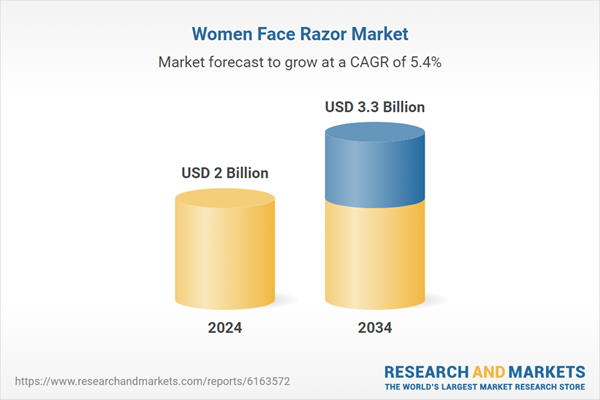Rising disposable incomes, especially in emerging markets, have made it easier for consumers to invest in accessible personal care tools. Time-constrained lifestyles and the desire for convenient, visible results have further heightened the appeal of facial razors. At the same time, product innovation has played a critical role in shaping the market. Enhanced blade designs, built-in safety features, and user-friendly ergonomics have improved both the experience and the performance of facial razors. These improvements have encouraged consumers to choose razors over alternative hair removal solutions, particularly those seeking gentler options for sensitive facial skin.
In 2024, the disposable face razors segment accounted for USD 1.6 billion and is expected to grow at a CAGR of 5.5% through 2034. This dominance stems from their affordability, convenience, and hygiene benefits. Single-use razors eliminate the need for replacement cartridges and offer a cleaner shaving option, especially for those prioritizing skin safety. Their low cost makes them particularly attractive to value-conscious buyers and emerging economies, where personal grooming habits are still evolving but growing quickly.
The manual razor segment captured an 83% share in 2024 and is expected to grow at a CAGR of 5.1% between 2025 and 2034. Simplicity and widespread accessibility are key factors behind this preference. Manual razors offer an easy solution without the need for batteries or charging, making them ideal for users on the go or those new to facial shaving. Their straightforward functionality continues to appeal to consumers who prioritize practical grooming tools that integrate seamlessly into everyday routines.
United States Women Face Razor Market generated USD 400 million and held a 76% share in 2024. Cultural acceptance, high disposable income, and broad participation in facial grooming routines have all propelled the U.S. market forward. Strong engagement with facial grooming practices among American women reflects a growing recognition of shaving as a mainstream, routine part of skincare. The normalization of facial razors as a beauty tool has made the U.S. one of the most developed markets for female grooming products globally.
Key companies actively shaping the Global Women Face Razor Market include Empower, LUI Body, Panasonic, BIC Group, Edgewell Personal Care, Procter & Gamble, Tweezerman, Dorco, Plush, Wilkinson Sword, REVLON, Merkur Shave, Perio, Koninklijke Philips, and KAI Group. To reinforce their market position, major players are focusing on developing skin-sensitive, ergonomically designed products tailored to female users. Many brands are investing in R&D to improve blade safety, durability, and comfort, while also rolling out subscription models and direct-to-consumer sales platforms to increase accessibility. Marketing partnerships with beauty influencers and dermatologists help build brand trust and awareness. In addition, several companies are expanding into eco-friendly and sustainable product lines, aligning with consumer demand for ethical and environmentally conscious grooming tools. Strategic pricing, wide product availability through e-commerce, and regional expansion are also central to their growth plans.
This product will be delivered within 2-4 business days.
Table of Contents
Companies Mentioned
The companies profiled in this Women Face Razor market report include:- BIC Group
- Dorco
- Edgewell Personal Care
- Empower
- KAI Group
- Koninklijke Philips
- LUI Body
- Merkur Shave
- Panasonic
- Perio
- Plush
- Procter & Gamble
- REVLON
- Tweezerman
- Wilkinson Sword
Table Information
| Report Attribute | Details |
|---|---|
| No. of Pages | 180 |
| Published | July 2025 |
| Forecast Period | 2024 - 2034 |
| Estimated Market Value ( USD | $ 2 Billion |
| Forecasted Market Value ( USD | $ 3.3 Billion |
| Compound Annual Growth Rate | 5.4% |
| Regions Covered | Global |
| No. of Companies Mentioned | 16 |









